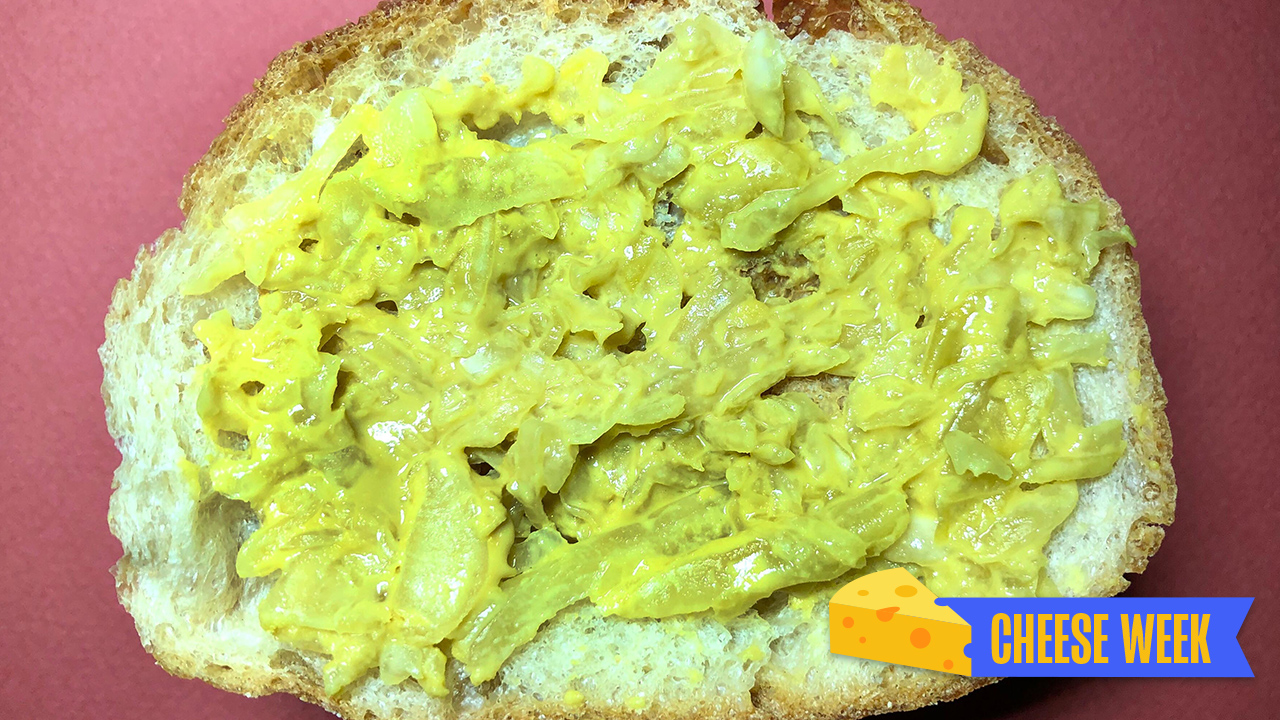How Sauerkraut Becomes Vegan "Cheese"
Welcome to Cheese Week, The Takeout's weeklong praise of cheeses.
Reducing your dairy intake is a personal choice, and much like Samin Nosrat, I still glug a massive pour of half-and-half into my morning triple espresso. I love eating hunks of tangy feta straight out of the container or dropping a blizzard of pecorino onto my pasta, as is my Mediterranean nature. But non-dairy cheese analogues can be pleasing too, and for the sake of fun and culinary adventure, trying store-bought and homemade faux cheeses is a hobby of mine.
However you feel about nut milk cheese, I'd take a single tub of Miyoko's Kitchen Classic Double Cream Chive wheel over a lifetime supply of the plastic-sleeved "real" cheese that always lets me down: yellow American. Only high-end organic singles are any good, and they have to be gently melted to activate that silky texture. Otherwise it's just cold, waxy, salty milk squares.
Vegan cheese's flavor development is not unlike traditional cheesemaking: a fat and a fermenting agent come together and do a dance, funking up the mix until it has the tang and richness we're used to in dairy offerings. Many of these recipes call for kefir or sauerkraut juice as a bacteria source, and usually nuts or tofu for fat. But most have at least some of this Lifehacker-beloved seasoning staple: nutritional yeast. Just like the real thing, these methods take preparation, time, and effort. In some cases, you have to press and dry the product for days to attain a firm texture, while fresher nut cheeses tend to be soft—not a bad thing, as they can mimic sheep ricotta and goat cheeses.

On top of all that cleanup, at sometimes upwards of $10 for a pound of quality raw nuts, I can see why anyone wanting a faux cheese would rather buy it pre-made. All of that sterilization, waiting, and labor is probably why even dairy cheesemaking isn't a widespread hobby. Also like dairy cheese, large-scale manufacturing ensures a more affordable, consistent, and convenient option than anything you could self produce.
This leaves anyone without time and organic cashews who is seeking a cheese-free addition to a sandwich with only pre-made faux slices—and they're not that great cold, just like processed dairy cheese. But after some bored/stoned sandwich crafting, I discovered there is a dastardly tasty and zero-effort solution using some of the base ingredients, with absolutely no cheesemaking involved. All you have to do is stir some sauerkraut and some of its juice with nutritional yeast to create a cheese-like condiment. To the delight of anyone feeling lazy or dealing with a tiny fridge, this is as minimalist as it gets.
Balk all you want, but this combo is delicious, turning a basic, dry, veggie burger into an umami paradise. If you've ever had a kimchi grilled cheese, or a pierogi with kraut, or tacos sprinkled with pickled red onions, you already have a feel for what this mixture adds to a plate. Combining the complex richness of nutritional yeast with the funky juices of salty cabbage kraut takes no time at all, and tastes like a precursor to Cheez Whiz.

Vegan “Cheese”
- 1/4 cup sauerkraut and some of its juices
- 1 Tbsp. nutritional yeast
Really, all you have to do is mix the two together. But if you don't even want to do that, just spread the sauerkraut onto sandwich bread and sprinkle the yeast, the juices will soak through and dampen the yeast pretty quickly. This is especially true if you use powdered nutritional yeast instead of the slightly more pricey flakes. If you're looking for something a little fattier, try adding a teaspoon of veganaise at a time. This is great for portable food, as there won't be any mayo or dairy to spoil while you run around town. This combo could switch up your dairy-free game, even if you are just pairing with cold cuts and not actually doing the no-animal-products thing. It goes beautifully on a crusty sandwich, grain bowl, or with an avocado and sliced tomato like a really hippie version of a caprese.
For a more kid-friendly version, you'll still need the blender, but you don't need the 10 dollars worth of tree nuts. Blend the kraut with a little bit of nondairy yogurt or silken tofu, adding turmeric, plenty of yeast, some garlic powder, and a pinch of salt if needed. You'll really nail that goopy-cheesy color and taste. This makes an amazing dip for crudités, roasted greens, nachos, elbow pasta, or lower fat eggs Benedict, blasphemy being my middle name.
If you want the full-blast vegan cheesemaking version, add a handful of soaked cashews to the blender. You can try adding sneaky nutrients via some steamed carrots, another kid pleaser. There's even the odd but tasty twist of adding half a can of drained, low-sodium chickpeas, a splash of pickle juice, and some olive oil for some drier, Handi Snacks, pub-cheese texture.
People have many reasons to not eat dairy, but the luscious taste of cheese is usually not one of them. We crave the unctuous fatty funk of these slabs of spoiled dairy like we crave sex and attention. So putting a little effort into finding these flavors outside of animal milk is really not so crazy, nor is this one much of a risk to try for yourself.
